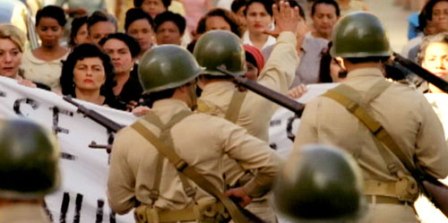Cuban Film Makers in Free Fall
By Esteban Diaz

This year I was able to go to the cinema in the little free time I have as a sixth year med student.
Through the new films produced by ICAIC (the Cuban Institute of the Art and Film Industry), you could appreciate the level of development of this artistic medium in the country.
There were movies such as “Kangamba”, “City in Red”, and a movie whose name I don’t remember but that was based on the bookParadiso, by Jose Lezama Lima.
In one of those presentations before the beginning a movie, ICAIC featured a short on the history of that institution during its beginning in the early years of the Cuban revolution.
The clip was received with a lively round of rejection by the audience – ranting, raving, whistling and poking fun.
This happens when such shorts are presented that go on longer than they should, and when they attempt to somehow impose on people the desire to see something that they don’t care to watch, something that doesn’t represent them.
A number of the moviegoers there expressed themselves with shouts that they were there to watch the feature, that they weren’t interested in listening about how some other people – the intellectuals – had been able to construct this cultural component of the Revolution.
Frankly, however, I believe that we should value the intellectuals of this institute for having developed such a solid film studio. However, it also must be kept in mind that one should respect the interests of others who also work – that is to say, Cuban society as a whole – before boasting about something.

I congratulate ICAIC for having produced these new films without the participation of Spain. The so-called co-productions invariably show a Cuban standing stark naked on the big screen (as if this were the most important Cuban “idiosyncrasy” for export) with this same individual ending up “falling in love” with a European, and leaving the country disheartened after bidding farewell to family, friends and country.
I’ve seen the old movies produced by ICAIC; they highlight those who remain and fight for their life and that of their country, as if they see no difference between the two.
I believe that the greatest error of Cuban filmmakers is perpetually showing the “ass” of Cuban society, as if here there are no fighters who day to day struggle for their family and their country, as if new activists do not emerge from every barrio.
Today each film attempts to motivate the public – by means of stories from 50 years ago – that the revolution was the best thing to ever happen to the Cuban people. But what’s happening in the present?
The Cuban intelligentsia is vegetating in their posh positions (air conditioning, cars, fashion attire and their “social prestige”) without relating to the society most committed to the country – those having fewer privileges.
This isn’t even mentioning ICAIC’s relation to social struggles that are being waged outside the country, and this is not about financing; after 50 years of revolution there should be abundant experience in this respect.
If we want to find committed cinematography, we should seek this among the low-budget cinematographers (seriously), those who are dispersed all over the world.
I salute all the committed film directors who are centering their efforts to respond to the needs of those most exploited.
